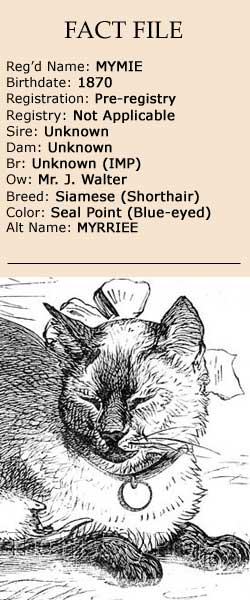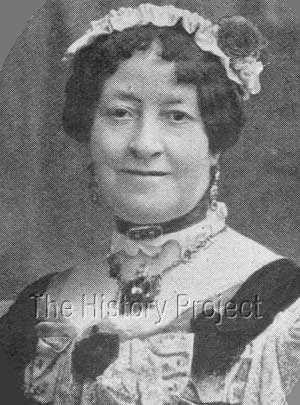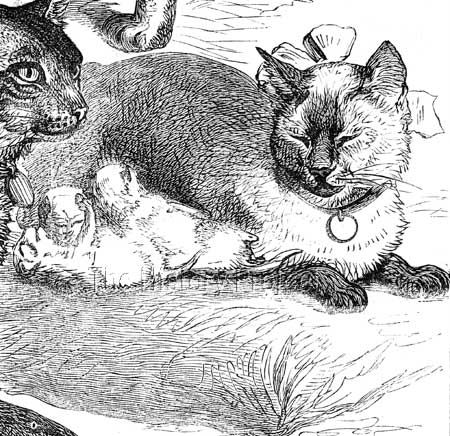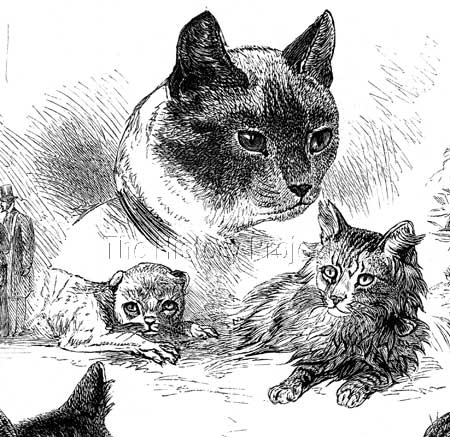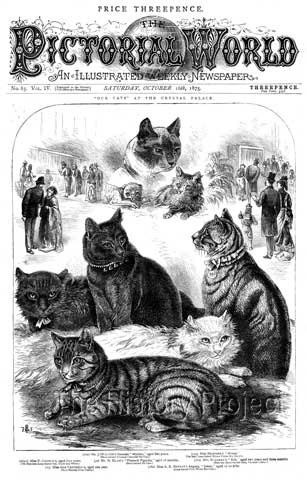 | ||||||||||||||||||









|
MYMIE (1870)PHOTOS | SOCIAL MEDIA | REFERENCES
HISTORICAL BACKGROUND:The Siamese, also known as the 'Wichien Maat' or 'Royal Cat of Siam', captured the imagination of Victorian cat fanciers from the very beginning. It tantalised their curiosity with its sinuous lines and seemingly elegant carriage, its uniquely pointed coat pattern and deeply mystical azure blue eyes. The story of 'Mymie' is singularly unique as she is the very first named Siamese cat for which there exists three key elements - evidence of ownership, an illustration, and confirmation that she was shown at The Crystal Palace as an adult aged 5 years, with her own progeny, in 1875. In the heady days of the pre-registry era, and before other famous importations occurred, among the earliest names associated with the importation of Siamese cats were Lady Dorothy Nevill, The Duke of Wellington, Mr. Scott, Mr. Maxwell and Mrs. Cunliffe Lee. It is worthy of note, that in his chapter on Siamese Cats, Harrison Weir leads the chapter with an illustration of a Siamese owned by Mrs. Cunliffe Lee, and speaks first about the Siamese cats owned by Lady Dorothy Nevill, on her estate at Dangstein, near Petersfield. PARENTAGE & OWNERSHIP:
Unknown
Unknown
| Unknown
Mymie, 1870, Seal Point Siamese, F
| Unknown
Unknown
Unknown
Harrison Weir's comments are succinct and informative: "Among the beautiful varieties of the domestic cat brought into notice by the cat shows, none deserve more attention than 'The Royal Cat of Siam'. In form, colour, texture, and length, or rather shortness of its coat, it is widely different from other short-haired varieties; yet there is but little difference in its mode of life or habit. I have not had the pleasure of owning one of this breed, though when on a visit to Lady Dorothy Nevill, at Dangstein, near Petersfield, I had several opportunities for observation. "I noticed in particular the intense liking of these cats for 'the woods' not passing along the hedgerows like the ordinary cat, but quickly and quietly creeping from bush to bush, then away in the shaws; not that they displayed a wildness of nature, in being shy or distrustful, nor did they seem to care about getting wet like many cats do, though apparently they suffer much when it is cold and damp weather, as would likely be on account of the extreme shortness of their fur, which is of both a hairy and a woolly texture, and, not so glossy as our ordinary common domestic cat, not is the tail, which is thin.
"Lady Dorothy Nevill informed me that those which belonged to her were imported from Siam and presented by Sir R. Herbert of the Colonial Office; the late Duke of Wellington imported the breed, also Mr. Scott of Rotherfield. Lady Dorothy Nevill thought them exceedingly docile and domestic, but delicate in their constitution; although her ladyship kept one for two years, another for over a year, but eventually all died of the same complaint, that of worms, which permeated every part of their body."6 Lady Dorothy's ownership of Siamese at Dangstein is corroborated by Guy Nevill in his biographical sketch of her life "Exotic Groves" which centres largely upon that period when she lived on the vast estate at Dangstein between 1850 and 1878. "Friends would send Dorothy exotic crates full of strange creatures: mice, half-brown, half-white, that Dorothy said got up in the middle of the night and danced and danced; lion dogs of China, bred at Goodwood by the Duchess of Richmond; a Kurdish sheepdog sent from Turkey by her brother Horace, which cost her £40 for its passage; a demoiselle crane dispatched from the Crimea by Sir John Mitchell which terrorised the chickens and ate their eggs; Siamese cats, a beautiful dun colour, specially bred by the King of Siam, so delicate they rarely survived long (although one of them, Mrs. Poodles, lasted long enough for Dorothy to show her at the Crystal Palace and duly won the gold medal); and some storks which ate everything."3 It should be noted that 'Mrs. Poodles' was not exhibited at the first Crystal Palace Show, it is more likely that she attended the fourth Crystal Palace Cat Show in October 1872. However, she may certainly have owned Siamese as early as 1868, well before those that were exhibited at the first Crystal Palace Cat Show in July of 1871. But the distinction and honour of the first Siamese cats to be exhibited at a Crystal Palace Show goes to two young Siamese, both owned by Mr. Maxwell. They appear in a press report published on the first day of the show but the reporter alludes to having seen the cats on the Wednesday "in a private viewing of the domesticated members of the feline race which are to be offered for public exhibition to-day at the Crystal Palace." It is a lengthy missive, but the relevant portion begins with: "On one side, between the statues of the Meleager of the Vatican and the Apollo of Capus, and close by his cousin-germans the Indian forest tigers, stuffed by Henry Ward, is caged the wild cat caught recently on the Duke of Sutherland's estates. A savage 'varmint' it is even still, and frets against its bars, or moves uneasily about like the lion Androcles physicked, holding up its wounded paw, a joint of which has been snapped off in the trap. The Manx cats, with their stumpy tails, are as funny as the pair from Siam, shown by Mr. Maxwell, are singular and elegant in their smooth skins and ears tipped in ebon, and blue eyes with red pupils."5
In another report, included in The Graphic but clearly based upon the previous report and written to accompany these illustrations states: "Our engravings represent the following specimens:The Siamese cats, a remarkable variety, quite new to the country. One writer speaks of them as 'soft fawn-coloured creatures with jet black legs - an unnatural nightmare kind of cat'. Another says they are 'singular and elegant in their smooth skins, and ears tipped with black, and blue eyes with red pupils'."4
SIBLINGS & SHOWS:Interestingly, although we have no names for the two cats shown above, a distinct possibility as to who they may have been arises when we survey two separate reports on the Crystal Palace Cat Show in October 1875. What we do know from the report is that they were owned and exhibited by Mr. Maxwell. He is again the successful exhibitor of Siamese at the Show of 1875, amongst the patrons of which were both Lady Dorothy Nevill and Mr. Charles Darwin. On this occasion, 323 cats were exhibited. Lady Dorothy had had a long association with Darwin during the period when he was studying orchids and still formulating his theories on evolutionary development. She had given many many samples of rare plants to assist him with his quest. In one short correspondence she had attempted to interest him in her Siamese cats: "I see in your interesting work of animals and plants on the cats you make no mention of the Siamese breed, of which I possess the only specimen. He is just like an otter with a brown fur coat and a beauty. I am not much in L (London) during the winter and if you will do me the great pleasure of calling on me I would bring him up and show him to you."3 Two illustrative reports were produced on the 1875 Crystal Palace Cat Show, which was held on October, 5th, 6th and 7th. Both were published on 16th October. One appeared in The Illustrated Sporting and Dramatic News, drawn by the respected animal artist Mr. R.H. Moore. In this illustration covering two-thirds of a page are featured six prize winning specimens, one of which is a Siamese, with the following description:: "….and beside this wild native of the land the Prince of Wales is journeying to is delineated the fine Siamese of Mr. J. Walter: Mymie, aged 5 years, victor in class 21 for 'short-haired unusual coloured she-cats'."1 The other illustration appeared as a full front page, under the caption "Our Cats at the Crystal Palace", featuring seven named cats and a couple of scenes within the Palace. At the top of the page is the head of a Siamese Cat, the caption below reading: "(112) Mr. J. Walter's Siamese, 'Myrriee', aged five years. (Short-haired Unusual Coloured She Cats)"2 Although the name of the cat is different, 'Mymie' versus 'Myrriee', the breed is the same, the ownership is the same, the award is the same and at the same show. This is therefore one and the same cat, with one name erroneously reported. Both reports corroborate on the fact that the exhibit was 5 years old, which puts her date of birth at 1870. This therefore makes 'Mymie' the first clearly identified named cat, for which there is a named owner, more than one illustration, and confirmation of a show win at the Crystal Palace. Sadly, although we have two Siamese owned by Mr. Maxwell, and an illustration that confirms them as the first Siamese exhibited at the very first The Crystal Palace Cat Show, we do not as yet, have any evidence of their names. Conversely we have evidence of Lady Dorothy Nevill's Siamese female, 'Mrs. Poodles' being exhibited at the Crystal Palace and gaining a major win, but no illustration. BREEDING & PROGENY:Although the illustrations do show 'Mymie' with a litter of kittens, there are no official records or commentaries which can confirm whether any progeny were retained and successfully bred from. PHOTOS:
SOCIAL MEDIA :
In Summary: As is so often the case with looking back into historical events where there is initially what appears to be a paucity of information, new facts emerge over time, as new sources are found and corroborative evidence slowly emerges. Sometimes those facts have always been there, but are waiting to be rediscovered. This is certainly true of the history of the Siamese cat and its foundations in England and its mercurial spread abroad, to all corners of the globe. Harrison Weir and Lady Dorothy Nevill have between them provided us with an amazing view into that past, and one is left wondering now, what has happened to that all-important Gold Medal won by Lady Dorothy's Siamese female 'Mrs. Poodles'. We can but wonder also, what may have become of a drawing of her Siamese cats executed by the great artist himself…evidence of its existence given in her biographical sketch which she penned about Harrison Weir: "Mr. Weir made the most delightful sepia sketches, and amongst my treasures I especially value the portrait of a lovely Siamese cat which he painted for me. He was also a proficient in the art of portraying with Nature, whilst in sketching birds his talent has never been equalled."8 This is a glowing recommendation of Harrison Weir's talents and abilities. We are fortunate indeed that he drew as many of the earliest Siamese as he did, including cats owned by Mrs. Cunliffe Lee and Lady Vyvyan. It is largely due to his 19th century Herculean efforts to promote the cause of the cat, that we have a vibrant and diverse cat fancy of today. But it is equally important that we do not discard or fail to remember the first steps taken in the process to develop that wonderful hobby, which we so much enjoy to this day; nor indeed, the reason behind it, which is to celebrate the divine, in the embodiment of the beautiful creature known as 'The Cat'. REFERENCES:
Registers associated with this article include The Incorporated Cat Fanciers Association of Great Britain (TICFAGB), National Cat Club (NCC), The Cat Club (CCR), Beresford Cat Club (BCC), Feline Federation Francaise (FFF), Siamese Cat Registry (SCR), US Register & Studbook for Cats (USR)including Supplement(USRS), The Studbook of the American Cat Association (ACA), and the Studbook & Register of the Cat Fanciers' Association (CFA).
|
|||||||||||||||||
Home | Cats | Gallery | Clubs | People | Artifacts | Articles | Updates | Contact Us ©The CFA Foundation, Inc and The Harrison Weir Collection
|
||||||||||||||||||
